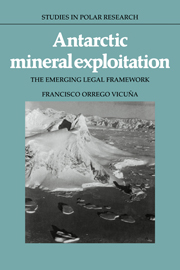Book contents
- Frontmatter
- Contents
- Preface
- Acknowledgement
- Abbreviations
- Part I The international legal framework of Antarctic co-operation and the development of resources
- Part II Alternative approaches to the conservation and development of Antarctic minerals: the process of internal accommodation
- 5 Basic elements of the regime for the exploration and exploitation of Antarctic mineral resources
- 6 Special policies pursued by the mineral resources regime
- 7 The distribution of powers within the regime: models and alternatives for accommodation
- 8 The institutional system of the mineral regime
- Part III Issues and options relating to the external accommodation
- Appendix 1 The Antarctic Treaty
- Appendix 2 Table of signatures and ratifications
- Table of Cases
- Table of Statutes and national legislation
- Table of Treaties
- Bibliography
- Index
5 - Basic elements of the regime for the exploration and exploitation of Antarctic mineral resources
Published online by Cambridge University Press: 04 November 2009
- Frontmatter
- Contents
- Preface
- Acknowledgement
- Abbreviations
- Part I The international legal framework of Antarctic co-operation and the development of resources
- Part II Alternative approaches to the conservation and development of Antarctic minerals: the process of internal accommodation
- 5 Basic elements of the regime for the exploration and exploitation of Antarctic mineral resources
- 6 Special policies pursued by the mineral resources regime
- 7 The distribution of powers within the regime: models and alternatives for accommodation
- 8 The institutional system of the mineral regime
- Part III Issues and options relating to the external accommodation
- Appendix 1 The Antarctic Treaty
- Appendix 2 Table of signatures and ratifications
- Table of Cases
- Table of Statutes and national legislation
- Table of Treaties
- Bibliography
- Index
Summary
The complexity of interests involved in the negotiation
When the Antarctic Treaty parties embarked on their consideration of mineral resources, the basic elements of the applicable regime gradually began to take shape. The principles approved by the preparatory meeting in Paris in 1976 were successfully taken up and developed by Recommendations IX-1, X-1 and XI-1, which defined the essential features of the content and scope of such a regime. These instruments were based on the deliberations of specialized working groups which were convened either on the occasion of the various Consultative Meetings or on an ad hoc basis.
The detailed elaboration of the mineral resources regime has been the result of the tasks undertaken by the Fourth Special Consultative Meeting which began its work in 1982. The negotiations that have taken place in that context were of a highly complex nature since they involved a confrontation of ideas that differed both on the nature of the Antarctic Treaty system and on the specific problems relating to the management and organization of mineral resources.
The first type of conflicting interests involved in these negotiations was the approach that has traditionally separated claimant countries from those that do not recognize claims of sovereignty, a difference of point of view which, in the case of mineral resources, is exacerbated by the fact that the link between these resources and the question of sovereignty or sovereign rights is stronger than in the context of other subjects.
- Type
- Chapter
- Information
- Antarctic Mineral ExploitationThe Emerging Legal Framework, pp. 185 - 278Publisher: Cambridge University PressPrint publication year: 1988
- 1
- Cited by



